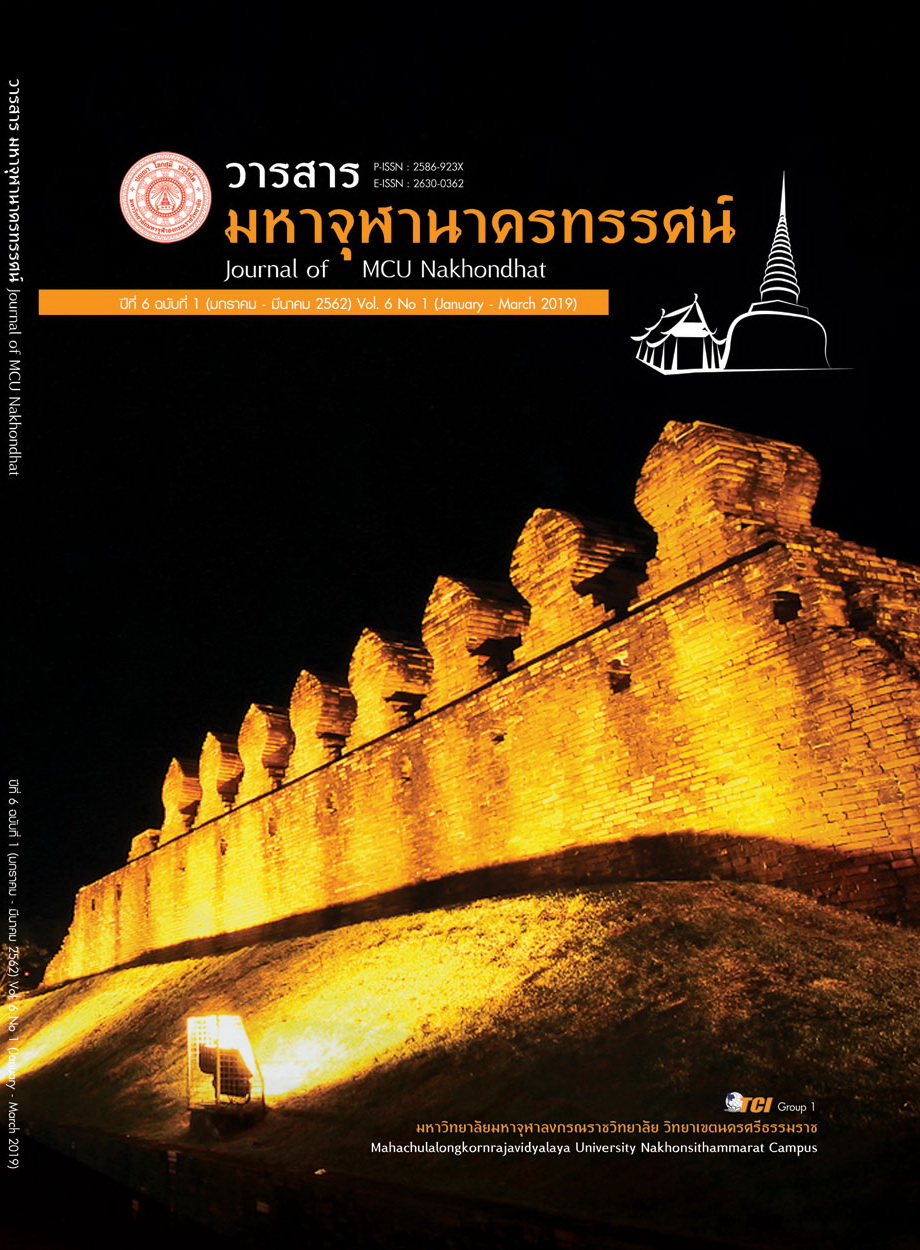THE YOUTHS’ MOTIVATION MODEL FOR FURTHUR STUDY IN PHRAPARIYATTIDHAMMA SCHOOL, GENERAL EDUCATION DIVISION.
Main Article Content
Abstract
The objectives of this research were; 1) to study state of motivation in further study of the youths in Phrapariyattidhamma School, General Education Division, 2) to develop a model of further study motivation of the youths in Phrapariyattidhamma School, General Education Division, 3) to propose the model of further study motivation of the youths in Phrapariyattidhamma School, General Education Division. The mixed research methods were used in the study. The quantitative data were collected by questionnaires from 331 students studying in Matthayom 1-6 in Phrapariyattidhamma School, General Education Division, and the analyzed by mean, percentage and standard deviation. The qualitative data were obtained by in-depth interviews with 12 key-informants and focus group discussions with 11 key-informants, and then analyzed by content analysis.
The research results found that;
The state of motivation in further study of the youths in Phrapariyattidhamma School, General Education Division was at a high level overall. The maximum level was on school achievement, followed by school environment, teaching and learning system, economic and personal reasons, public relations and family and individuals concerned respectively. The development of a motivation model be done by building good image, educational management potential, educational quality, good and successful alumni, pleasurable environment and atmosphere, positive attitude among the youths in education, and trust and confidence of students’ parents and guardians. Furthermore, the school must implant the faith in Buddhism to students and encourage them to be studious and develop themselves gradually
and continuously.
The research results could be synthesized into the “ISEIS2P2FO Model” referring to Institution, Success, Environment, Teaching and Learning Management, Economic and Society, Personal Reason, Public Relations, Family and Concerned Individuals, Faith and Educational Opportunity.
Article Details
References
กองพุทธศาสนศึกษา. (2553). แผนยุทธศาสตร์และแผนปฏิบัติการ การพัฒนาการศึกษาโรงเรียนพระปริยัติธรรมแผนกสามัญศึกษา พ.ศ.2553-พ.ศ.2562. กรุงเทพมหานคร: สำนักงานพระพุทธศาสนาแห่งชาติ.
กอบพร นิยมราษฎร์. (2553). การตัดสินใจในการเลือกเข้าศึกษาต่อในคณะวิทยาการจัดการ. วิทยานิพนธ์มหาบัณฑิต: คณะวิทยาการจัดการ: มหาวิทยาลัยศิลปากร.
จุฑามาศ ชูจินดา และคณะ. (2555). แรงจูงใจในการศึกษาต่อระดับอุดมศึกษาของนักเรียนชั้นมัธยมศึกษาปีที่ 6 และประกาศนียบัตรวิชาชีพชั้นปีที่ 3 ในเขตจังหวัดนนทบุรี. วิทยานิพนธ์มหาบัณฑิต: บัณฑิตวิทยาลัย: วิทยาลัยราชพฤกษ์.
เตือนใจ อารีโรจนนุกูล. (2555). ปัจจัยที่มีอิทธิพลต่อการตัดสินใจเลือกศึกษาต่อสายอาชีพของนักเรียนระดับชั้นประกาศนียบัตรวิชาชีพชั้นปีที่ 1 วิทยาลัยเทคโนโลยีพายัพ และบริหารธุรกิจ. วิทยานิพนธ์มหาบัณฑิต: วิจัยสถาบัน: วิทยาลัยเทคโนโลยีพายัพและบริหารธุรกิจ.
เมธาวี สุขปาน. (2556). ปัจจัยที่มีผลต่อการตัดสินใจเลือกศึกษาต่อในหลักสูตรประกาศนียบัตรวิชาชีพชั้นสูง (ปวส.)ของนักเรียนกรณีศึกษาวิทยาลัยพณิชยการธนบุรี. วิทยานิพนธ์มหาบัณฑิตบัณฑิตวิทยาลัย: มหาวิทยาลัยธุรกิจบัณฑิต.
รณชัย คงกะพันธ์. (2553). ปัจจัยที่มีผลต่อการเลือกเรียนสถาบันอุดมศึกษาของนักเรียนสายอาชีวศึกษาในจังหวัดภูเก็ตและพังงา. วิทยานิพนธ์มหาบัณฑิต: บัณฑิตวิทยาลัย: วิทยาลัยราชพฤกษ์.
ศศิวิมล แสนเมือง. (2554). ปัจจัยที่ส่งผลต่อการตั้งใจเลือกมหาวิทยาลัยเทคโนโลยีสุรนารีของนักเรียนที่มีผลการเรียนดีในเขตภาคตะวันออกเฉียงเหนือตอนล่าง. วิทยานิพนธ์มหาบัณฑิต: มหาวิทยาลัยเทคโนโลยีสุรนารี: นครราชสีมา.
ศักดิ์ไทย สุรกิจบวร. (2548). การวิเคราะห์งานวิจัยทางการบริหารการศึกษา. สกลนคร: มหาวิทยาลัยราชภัฎสกลนคร.
ศิรินภา ศรีโคกล่าม. (2556). แรงจูงใจในการเลือกศึกษาต่อสถาบันการพลศึกษาของนักศึกษาชั้นปีที่ 1ในเขตภาคกลางปีการศึกษา 2555. วิทยานิพนธ์มหาบัณฑิต: บัณฑิตวิทยาลัย: มหาวิทยาลัยศรีนรินทรวิโฒ.
Krejcie and Morgan. (1970). Determining Sample Size for Research Activities Educational and Psychological Measurement.


